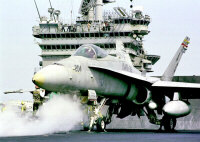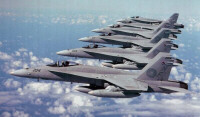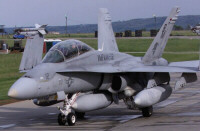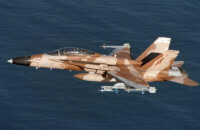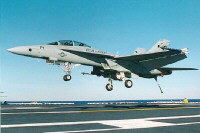| MILAVIA > Aircraft > F/A-18 | Last updated: 15 May 2004 |

|
> Information |
McDonnell Douglas F/A-18 Hornet
Role: multi-role fighter/attack aircraft The F/A-18 Hornet is a twin engine combat aircraft capable of carrying out both air-to-ground as air-to-air missions. Originally designed for the US Navy it can also operate from aircraft carriers. The F/A-18 is a true multi-role aircraft capable of a wide variety of roles: air superiority, fighter escort, suppression of enemy air defenses, reconnaissance, forward air control, close and deep air support, and day and night strike missions at almost all weather conditions. Despite its marginal range, the F/A-18 Hornet has become a valuable asset for the Carrier Battle Group. The F/A-18 has a digital fly-by-wire flight control system to improve the aircraft's handling, maneuverability and allows the pilot to concentrate on operating the weapons system. The cockpit is equipped with three multi function displays. The F/A-18 has a good thrust-to-weight ratio, superior turn characteristics and great energy sustainability compared to other fighters of its time. The entire avionics suite is digital which enables easy upgrades and software changes. F/A-18A/B were the first single and two seat production aircraft, which were followed by F/A-18C/D variants. Although the single seat variants, A and C, were first equipped with the AN/APG-65 radar, since 1994 all US Hornets feature the improved AN/APG-73 radar. The second seat of the B and D models is often manned by a weapon system operator or instructor. CF-18 refers to the Canadian aircraft, the official Canadian Forces designation is CF-188. Other designations for the F/A-18 Hornet are the EF-18A Growler which will replace US Navy EA-6B Prowler electronic warfare aircraft and the RF-18 which is a dedicated reconnaissance version. The EF-18 designation is also used for Spanish F/A-18A/B Hornets where the E stands for Espanga. The F/A-18 designation is used to reflect the aircraft's multi-mission capability, but often it is called just F-18. Although the F/A-18 designation is used in official US Navy and Department of Defense documents, FA-18 is the registered designation for the type. The F/A-18E/F variants are the single and two seat version of the Super Hornet. The Super Hornet is the latest generation of the F/A-18 which is much improved. It has new engines, bigger air intakes, the airframe itself is much longer. Weapon systems are much improved, as well as a better radar. A larger internal fuel capacity and larger ordnance carrying capacity improves the range significantly. F/A-18F Super Hornets with a WSO in the rear seat are replacing the F-14 Tomcat. Critics see this as a step back for the US Navy in fleet defense because of the smaller range of the Super Hornet and its weapons compared to the F-14 and its long range AIM-54. |
|
Copyright © 2002-2004 Niels Hillebrand unless stated otherwise. All rights reserved.

